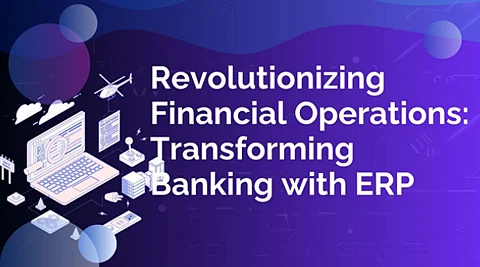

The integration of Enterprise Resource Planning (ERP) systems in the banking sector has redefined financial operations, enhancing efficiency, accuracy, and compliance. Eswar Sanka, a recognized researcher in financial technology, delves into how ERP innovations are transforming banking processes. His insights shed light on the technological advancements shaping the future of financial management.
One of the most impactful contributions of ERP systems is their ability to integrate core financial functions into a unified platform. Traditionally, banking institutions operated disparate systems for accounting, budgeting, and financial reporting. ERP solutions eliminate these silos, enabling real-time data sharing and streamlined workflows. This consolidation minimizes errors, accelerates processing, and enhances decision-making by providing executives with a holistic financial overview.
Furthermore, modern ERP implementations in banking offer advanced analytics capabilities, transforming raw financial data into actionable insights. These systems facilitate regulatory compliance through automated reporting and audit trails while supporting multi-currency operations critical for international banking. Cloud-based ERP solutions provide scalability and reduce infrastructure costs, allowing institutions to adapt quickly to market changes. The integration extends beyond finance to encompass customer relationship management, human resources, and risk assessment, creating a comprehensive operational ecosystem that drives competitive advantage and customer satisfaction..
Automation has-laid down ERP systems through to a great extent manual interference in the transaction that happens within them. Most conventional banking activities like invoicing, reconciliation, and payment processing are now achieved with far greater accuracy and speed. This means-their banks can automate the whole transactional process thereby scaling up the volume of the transaction without raising the over-all costs of operations: both scalable and efficient.
It goes a step further even in difficult financial operations such as credit risk assessment, compliance verification, and fraud detection through the advanced algorithms and machine learning applications. Those employees who were spending most of their time doing routine jobs now have time to add value by engaging the customer in various initiatives. Operational excellence means faster service delivery, which improves customer satisfaction. In addition, automated workflow creates virtual and complete digital audits that are greatly beneficial to enhance governance and regulatory reporting. Real-time handling of exceptions enables mismatches to be resolved as soon as possible, while predictive analytics capability allows institutions to gain insight into market trends and customer needs, thus preparing them for strategic growth amidst a competitive financial environment.
Under these portability conditions, risk management and administration are newly conceptualized: starting from ERP systems with built-in artificial intelligence and machine learning. Predictive analytics transform how these systems assess a client for creditworthiness at the point, eliminate fraud, and prevent financial loss in real time. Continuous learning of algorithms for the development of machine learning can lead credit institutions into reactive action even before the market begins to shake with other approaches to threat assessment. These enable the processing organization to become better equipped on safety and stability fronts within the financial ecosystem.
Marrying behavioral biometrics with pattern recognition is one of the other steps that fortify a certain authentication concatenate by first identifying most of these "anomalous" transactions before they can affect customers. Advanced scenario modeling creates the ability for institutions to be able to conduct stress-testing of portfolios against different prevailing conditions in the economy, thus optimizing capital allocation and liquidity management. These AI systems develop an eye towards monitoring the changes that arise in regulations around the world and automatically adjusting their compliance frameworks as measures to minimize exposure to legal risks. Modern ERP systems combine internal data with external indicators from the markets to construct fully-fledged risk dashboards that democratize risk intelligence across levels within organizations and promote a more risk-aware culture across the institution.
The Cloud has thrown more light on the ERP systems and thrown the banks into an unprecedented era of flexibility and scalability. Cloud-based ERP solutions allow for remote access, real-time data updates, and continuous upgrade of systems. Such functionality offers financial institutions the ability to keep up with changing market demands while still providing uninterrupted service. Further, cloud security enhancements are also shielding sensitive data, helping prevent data from being compromised and taking the measure of the cyber-security of the banking operations.
Consider the digital transformation strategy followed by JPMorgan Chase to decipher the true-world impact of ERP. This banking behemoth deployed cloud-based ERP solutions for enhanced real-time financial reporting while mitigating operational risks and optimizing transaction processing. In addition, through AI-enabled ERP tools, they automated the compliance-tracking mechanisms, thus leading to a major reduction in audit costs while better abiding by regulations. Similarly, in Europe, ING Group's ERP-enabled cash management systems have enhanced liquidity management and transaction reconciliation speed, which, when combined, have translated into service delivery and profitability for clients. Thus, these triumph tales offer insight into the fact that ERP is no longer an operational enhancement but a strategic necessity for financial institutions drifting with the accelerating winds of a changing financial environment.\
ERP systems will, therefore, be the centerpiece of innovation as financial institutions continue to progress through their digital transformation journeys. In such circumstances, the integration of blockchain technologies, AI-driven automation, and advanced analytics will further fine-tune financial processes. Through the acceptance of these technologies, banks can optimize their operational resilience and enhance their customer experience and competitiveness within the changing contours of the ever-challenging financial environment. The analysis presented by Eswar Sanka further cemented ERP's role as a lever for change by the banking industry. As these systems evolve, they will continue to design the future of the banking industry, taking operational efficiency, security, and compliance to unprecedented levels.
